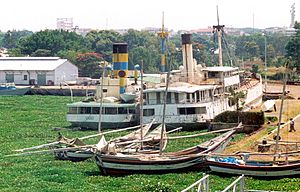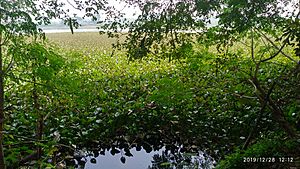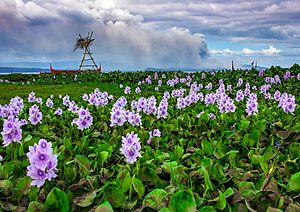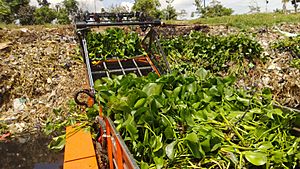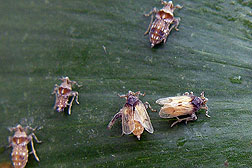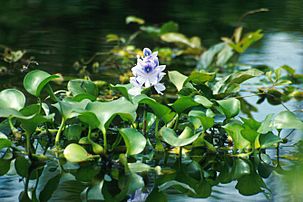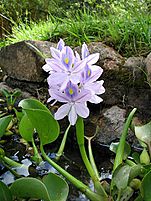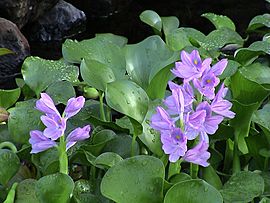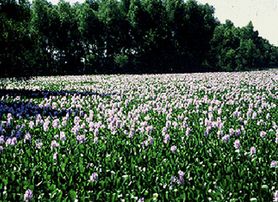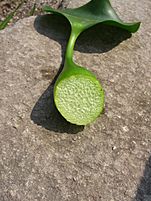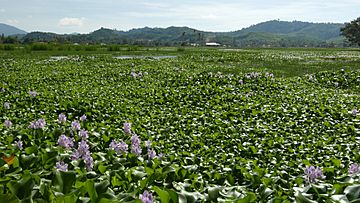Pontederia crassipes facts for kids
Quick facts for kids Common water hyacinth |
|
|---|---|
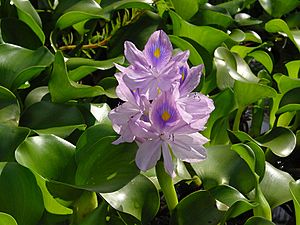 |
|
| Scientific classification | |
| Genus: |
Pontederia
|
| Species: |
crassipes
|
| Synonyms | |
The Pontederia crassipes is a water plant often called the common water hyacinth. It originally comes from South America. Today, you can find it all over the world, but it often grows too much and becomes an invasive plant where it doesn't belong. Some people even call it the "terror of Bengal" because it spreads so quickly!
Contents
What is Water Hyacinth?
Water hyacinth is a plant that floats freely on water. It lives for many years (a perennial) and loves warm, tropical places. Its leaves are wide, thick, and shiny, shaped like an egg. The plant can grow up to about 3 feet (1 meter) tall above the water.
Its leaves are about 4 to 8 inches (10–20 cm) wide. They sit on a stem that floats because of special bulb-like parts at its base. The roots are dark purple and hang freely in the water. Each plant has a tall stem with 8 to 15 pretty flowers, usually light purple or pink. When it's not flowering, water hyacinth can look like other water plants such as frog's-bit.
How Water Hyacinth Reproduces
Water hyacinth is one of the fastest-growing plants known! It mostly reproduces using "runners" or stolons. These are like little stems that grow out and form new baby plants.
Each plant can also make thousands of seeds every year. These seeds can stay alive for more than 28 years, waiting for the right conditions to grow. Water hyacinth plants grow so fast that a patch of them can double in size in just one to two weeks! In less than a month, their numbers can increase by more than a hundred times.
In their native home, long-tongued bees help these flowers make seeds. They can reproduce both by seeds (sexually) and by making clones of themselves. The reason water hyacinth is so invasive is its amazing ability to clone itself. Large groups of these plants are often all genetically the same.
Water hyacinth flowers come in three different shapes, which is called "tristylous". These shapes are named after the length of their central part (the pistil): long, medium, and short. However, in places where the plant has been introduced, you mostly see the medium shape, sometimes the long shape, but never the short shape. This shows that the plants that first spread to new areas played a big role in how the species spread worldwide.
Where Water Hyacinth Lives
Water hyacinth can live in many different climates, from hot deserts to warm rainforests. It likes temperatures between 77–86°F (25–30°C) best. It can't grow if the water is colder than 54°F (12°C) or hotter than 93°F (34°C). It also prefers water that is not too salty. If the water is too salty, its leaves will turn yellow and die.
This plant can contain tiny, sharp crystals. It might also have chemicals that can cause itching. If the plants are sprayed with certain chemicals or grow in polluted water, they can gather harmful substances.
Why Water Hyacinth is a Problem
Water hyacinth grows and reproduces so quickly that it can cover huge parts of ponds and lakes. This is especially true in places where human activities have already affected the water, like man-made lakes or lakes with too many nutrients (called eutrophied lakes).
When water hyacinth takes over, it pushes out native water plants, both those that float and those that grow underwater. This can harm the entire ecosystem. When the water hyacinth dies, it sinks and rots, using up the oxygen in the water. This often kills fish and other aquatic animals.
Water hyacinth can also soak up a lot of harmful heavy metals and other bad stuff. But when it dies and rots, these harmful things can go back into the water, making the water quality worse. This can even affect people's drinking water. Lakes with a lot of water hyacinth can also become breeding grounds for disease vectors like mosquitoes and snails, which can spread diseases to people.
Impact on People and Travel
The spread of water hyacinth also causes problems for people and their communities. Since the plant is mostly water (95%), it releases a lot of water into the air. Small lakes covered with water hyacinth can dry up, leaving communities without enough water or food.
Thick mats of water hyacinth can block waterways, making it impossible for boats to travel. This means people can't transport goods or themselves, and they can't go fishing. Governments spend a lot of money trying to remove water hyacinth. Removing it mechanically is a huge job. Imagine needing 75 large trucks every day for a whole year to get rid of a million tons of this plant! Then, when it decomposes, it releases gases that harm air quality and contribute to global warming.
Where it has Spread
Water hyacinth has been introduced to many places around the world, including North America, Europe, Asia, Australia, and New Zealand. In many of these areas, it has become a serious invasive species. For example, in New Zealand, it's illegal to grow, sell, or spread it. It's a big problem in places like Louisiana, the Kerala Backwaters in India, Tonlé Sap in Cambodia, and Lake Victoria in Africa.
Water Hyacinth in the United States
People have different stories about how water hyacinth first came to the U.S.
- The 1884 World's Fair: Many believe it was introduced at the World's Fair in New Orleans in 1884. Some stories say a Japanese group gave the plants away as gifts. People then threw them into waterways, and they started to spread.
- Other Ways it Arrived: The plant was also sold in plant catalogs as early as 1864. Someone from New Orleans reportedly brought water hyacinths from Colombia around 1892, and they quickly multiplied.
Controlling it in the Southeast U.S.
By the early 1900s, water hyacinth was causing big problems in states like Louisiana and Florida. It was choking rivers and making it hard for boats to pass. The U.S. Army Corps of Engineers tried different ways to get rid of it, like using steam, strong acids, or even oil and fire. They also used herbicides (plant-killing chemicals) that contained arsenic, but this was later stopped.
In 1910, a very unusual idea came up: bring hippos from Africa to eat the water hyacinth! This plan, called the "American Hippo Bill," was discussed in the U.S. Congress. Supporters argued that since many farm animals in the U.S. were brought from other countries, hippos could also be introduced to eat the plants and provide meat. However, the bill did not pass.
Water hyacinths have also been put into waters where manatees live in Florida. The idea was for the manatees to eat the plants and help clean the water. Manatees do eat water hyacinth, but it might not be their favorite food.
Laws About Water Hyacinth in the U.S.
For many years, it was illegal to sell or ship water hyacinth in the United States. This law was changed in 2020.
Water Hyacinth in Africa
Water hyacinth may have arrived in Egypt in the late 1700s or early 1800s. It became a recognized problem there by 1879. It also spread to South Africa around 1910, causing big issues in dams like the Hartebeespoort Dam.
Belgian colonists brought the plant to Rwanda to make their gardens look pretty. From there, it spread naturally to Lake Victoria, one of Africa's largest lakes. It was first seen there in 1988. Without any natural enemies, it became a huge problem, suffocating the lake, reducing fish, and harming local economies. It made it hard for boats to reach ports like Kisumu.
The plant has also appeared in Ethiopia, first reported in 1965. It's now a serious issue in places like Lake Tana and the Blue Nile River. It's also found in the Shire River in Malawi.
Water Hyacinth in Asia
Water hyacinth came to Asia after 1884. Because it had no natural enemies, it multiplied very quickly and caused big problems.
In Bengal, India, it was brought for its beautiful flowers. But it became a harmful weed, taking oxygen from the water and destroying fish populations. People called it the "blue devil" or "Bengal terror." In Bangladesh, some called it "German weed," believing German submarines brought it during World War I. In Sri Lanka, it was called "Japanese trouble" due to a rumor that the British planted it.
In Bangladesh, some farmers are now using water hyacinth to build "floating vegetable gardens."
The plant has also invaded Tonlé Sap Lake in Cambodia. A project there teaches local people to make baskets from the plant to help control it.
Water hyacinth came to Japan in 1884 for gardens. However, old Japanese artwork from 1855 shows the plant, suggesting it was there even earlier.
In the 1930s, water hyacinth was brought to China to be used as animal food, an ornamental plant, and to help clean sewage. But by the 1980s, as China's industries grew, the water became richer in nutrients, and water hyacinth spread rapidly. It blocked rivers, making boat travel difficult. It also blocked sunlight from reaching other plants and polluted the water when it decayed, harming local ecosystems and people's health.
In Iraq, water hyacinth, brought in the 1990s as a decorative plant, caused major problems for water supplies and fishermen in the Euphrates River.
Water Hyacinth in Europe
In 2016, the European Union made it illegal to sell, import, grow, or intentionally release water hyacinth anywhere in the EU. It is now on their list of "Invasive Alien Species of Union Concern."
Water Hyacinth in Oceania
In Papua New Guinea, water hyacinth blocked sunlight for other water life. It also created homes for mosquitoes that carry malaria. It clogged waterways, stopping boats, and made water unsafe for cooking, washing, and drinking. People lost income and even died because they couldn't travel for food or medical help, or from diseases caused by dirty water and mosquitoes.
How to Control Water Hyacinth
Controlling water hyacinth depends on where it is, how much there is, the climate, and how close it is to people and wildlife.
Using Chemicals
Chemical control uses special sprays called herbicides to kill the plants. This is usually the last choice because of its long-term effects on the environment and people. It's mostly used for smaller areas where the plants have just started to spread. While it can be cheaper than other methods, the chemicals can get into groundwater and harm water systems and human health. Also, these chemicals can kill other important plants and animals, not just the water hyacinth.
Common herbicides used include 2,4-D, glyphosate, and diquat. 2,4-D kills the plant by stopping new cell growth. It can take about two weeks for the plants to die. Diquat works faster, quickly damaging the plant cells. Glyphosate is less toxic but takes longer (about three weeks) to kill the plants, making them wilt and turn yellow.
Physical Removal
Physical control means removing the plants using machines. This can be done with machines on land, like cranes, or machines on water, like aquatic weed harvesters.
Mechanical removal is a good short-term solution. For example, a project on Lake Victoria removed about 3,700 acres (1,500 hectares) of water hyacinth in a year. However, it's very expensive, costing millions of dollars each year. It also requires a lot of equipment and people.
One big problem with mechanical harvesting is that it can break the plants into small pieces. These pieces can then easily grow into new plants, causing another infestation. Also, the harvested plants are very heavy and hard to transport and dispose of. They can also be toxic because they absorb pollutants, posing a health risk. This method is not effective for very large areas because the plants grow much faster than they can be removed.
Biological Control
Since chemical and mechanical methods are often too costly or harmful, scientists have looked for natural ways to control water hyacinth. This is called biological control.
In the 1970s, researchers in the U.S. released three types of weevils (small beetles) that eat water hyacinth. These weevils were introduced in states like Louisiana, Texas, and Florida. After about ten years, the amount of water hyacinth decreased by a third. These insects help by limiting the plant's size, how it spreads, and how many seeds it makes. They also carry tiny organisms that can harm the water hyacinth. The weevils eat the plant's stems, making it lose its ability to float and eventually sink. These weevils have been used in many other countries too.
In 2010, another insect, Megamelus scutellaris, was released as a biological control. This small insect is from Argentina and only eats water hyacinth, so it won't harm other plants. Scientists hope it will be even more effective than other controls.
Another insect being considered is the grasshopper Cornops aquaticum. This grasshopper also eats only water hyacinth and can introduce diseases to the plant. It has been tested in South Africa.
Introducing manatees to waterways has also helped control the plant's growth in Guyana.
How Water Hyacinth Can Be Used
Because water hyacinth grows so much, harvesting it for different uses can also help control its spread.
Making Energy
Water hyacinth grows very fast, making it a great source for biomass (plant material that can be used for energy). One acre of water hyacinth can produce a lot of biogas, which is a fuel similar to natural gas. It can also be used to make ethanol, another type of fuel.
Farmers in Bengal, India, collect and dry these plants to use as fuel in the cold season. The ashes left over are then used as fertilizer.
Cleaning Water
Water hyacinth can help clean water! It can remove arsenic from drinking water, which is a big problem in places like Bangladesh.
It also helps clean wastewater treatment by improving a process called nitrification. Its roots are excellent places for helpful bacteria to grow.
This plant is very good at soaking up heavy metals like cadmium, chromium, lead, and mercury from water. This means it could be used to clean industrial wastewater. It can also absorb harmful organic chemicals that are believed to cause cancer. Water hyacinth can even break down pesticides like ethion.
In Agriculture
Where water hyacinth is a problem, it can be harvested for free. This makes it very useful as organic matter for compost in organic farming. It's used around the world as fertilizer and as animal feed for cattle, sheep, geese, pigs, and other livestock.
In Bangladesh, farmers in low-lying areas use dried water hyacinth to make "floating gardens" for growing vegetables during the monsoon season when their land is underwater.
Other Uses
People in different parts of the world use water hyacinth to make furniture, handbags, baskets, rope, and home decorations like lampshades.
Woven Products
An American-Nigerian woman named Achenyo Idachaba won an award for showing how water hyacinth can be used to make profitable woven products in Nigeria.
Paper
While it's not the best material for paper, water hyacinth is used on a small scale to make paper. Adding water hyacinth pulp to bamboo pulp can make paper stronger.
Can You Eat It?
In Taiwan, the plant is eaten as a vegetable because it's rich in carotene. People in Java and Vietnam sometimes cook and eat the green parts and flowers, or add young leaves and flowers to salads.
Medicinal Use
In Kedah, Malaysia, the flowers are used to treat the skin of horses. The plant is also considered a "tonic."
Fighting Other Weeds
Extracts from water hyacinth leaves have been shown to stop the growth of another invasive weed called Mimosa pigra. The extract prevented its seeds from sprouting and slowed down root growth.
Images for kids
See also
 In Spanish: Jacinto de agua para niños
In Spanish: Jacinto de agua para niños


